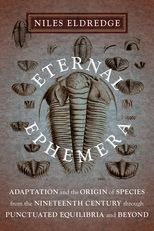Eternal Ephemera: Adaptation and the Origin of Species from the Nineteenth Century Through Punctuated Equilibria and Beyond
Eternal Ephemera: Adaptation and the Origin of Species from the Nineteenth Century Through Punctuated Equilibria and Beyond
Cite
Abstract
This book follows the development of evolutionary science over the past two hundred years. It highlights the fact that life endures even though all organisms and species are transitory or ephemeral. It goes on to explain that the extinction and evolution of species—interconnected in the web of life as “eternal ephemera”—are key concerns of evolutionary biology. The book begins in France with the naturalist Jean-Baptiste Lamarck, who in 1801 first framed the overarching question about the emergence of new species. It moves on to the Italian geologist Giambattista Brocchi who brought in ideas from geology and paleontology to expand the question. It details how, in 1825, at the University of Edinburgh, Robert Grant and Robert Jameson introduced the astounding ideas formulated by Lamarck and Brocchi to a young medical student named Charles Darwin and follows Darwin as he sets out on his voyage on the Beagle in 1831. The book revisits Darwin's early insights into evolution in South America and his later synthesis of his knowledge into the theory of the origin of species. It then considers the ideas of more recent evolutionary thinkers, such as George Gaylord Simpson, Ernst Mayr and Theodosius Dobzhansky, as well as Niles Eldredge and Steven Jay Gould, who developed the concept of punctuated equilibria. The book provides many insights into evolutionary biology, and celebrates the organic, vital relationship between scientific thinking and its subjects.
-
Front Matter
- Introduction Approaching Adaptation and the Origin of Species
-
I Birth of Modern Evolutionary Theory
-
II Rebellion and Reinvention: The Taxic Perspective, 1935–
-
End Matter
Sign in
Personal account
- Sign in with email/username & password
- Get email alerts
- Save searches
- Purchase content
- Activate your purchase/trial code
Institutional access
-
Sign in through your institution
- Sign in with a library card Sign in with username/password Recommend to your librarian
Institutional account management
Sign in as administratorPurchase
Our books are available by subscription or purchase to libraries and institutions.
Purchasing information


Get help with access
Institutional access
Access to content on Oxford Academic is often provided through institutional subscriptions and purchases. If you are a member of an institution with an active account, you may be able to access content in one of the following ways:
IP based access
Typically, access is provided across an institutional network to a range of IP addresses. This authentication occurs automatically, and it is not possible to sign out of an IP authenticated account.
Sign in through your institution
Choose this option to get remote access when outside your institution. Shibboleth/Open Athens technology is used to provide single sign-on between your institution’s website and Oxford Academic.
If your institution is not listed or you cannot sign in to your institution’s website, please contact your librarian or administrator.
Sign in with a library card
Enter your library card number to sign in. If you cannot sign in, please contact your librarian.
Society Members
Society member access to a journal is achieved in one of the following ways:
Sign in through society site
Many societies offer single sign-on between the society website and Oxford Academic. If you see ‘Sign in through society site’ in the sign in pane within a journal:
If you do not have a society account or have forgotten your username or password, please contact your society.
Sign in using a personal account
Some societies use Oxford Academic personal accounts to provide access to their members. See below.
Personal account
A personal account can be used to get email alerts, save searches, purchase content, and activate subscriptions.
Some societies use Oxford Academic personal accounts to provide access to their members.
Viewing your signed in accounts
Click the account icon in the top right to:
Signed in but can't access content
Oxford Academic is home to a wide variety of products. The institutional subscription may not cover the content that you are trying to access. If you believe you should have access to that content, please contact your librarian.
Institutional account management
For librarians and administrators, your personal account also provides access to institutional account management. Here you will find options to view and activate subscriptions, manage institutional settings and access options, access usage statistics, and more.